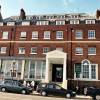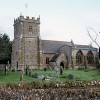When their eldest son William met with his fatal accident in May 1881 it is almost certain that William and Hannah Cheeseman (by then Chisman) were again living at Winfrith. They were not however to resettle there immediately and within at most eighteen months they had again moved.
William was once more hired as a shepherd, this time at Church Knowle on the Purbeck Hills, some eight miles to the west of Winfrith. Two years after the death of young William, Hannah bore her last child, a son, who was born at Church Knowle in 1883. Hannah was by then aged thirty-five, while William was fifty-five.
It is known that at least one of his sons did not consider William to be a good father. Indeed there is a suggestion that William was in fact a drunkard. When the Chismans were living at Blacknoll it is very possible that James Hibbs and William’s mother Amelia had been a restraining influence. However, with their deaths that influence had ended and perhaps the material situation of William and Hannah had simultaneously deteriorated. The move to Milton Abbas, the return to Winfrith and the further move to Church Knowle indicate a less settled state and family tensions could have been heightened by the death of the eldest son.
After the birth of their last child in 1883 matters clearly worsened. Did an ageing William resent his younger wife’s energy? Did a deeper resentment and memory of the circumstances of their marriage irritate him? Was he naturally a drunkard, or was he provoked by circumstances? Was he angered by some element in Hannah’s behaviour? The questions readily present themselves, but the situation in the Chisman household remains hidden. There is, however, one certainty: William and Hannah were to part.
The date and circumstances of their separation are not known. Perhaps it was after a return from Church Knowle to Blacknoll that Hannah left William, taking the children with her. Perhaps the family had moved to Portway at Winfrith and William had then deserted them. All that is certain is that at some point before the end of 1890 Hannah found herself installed at Portway Farm with some of her children. Hannah had become the head of the household and of William there was no sign.
Subsequent events sadly afford no reason for believing that Hannah’s separation from William was without animosity. If the situation had been such that William had been forced out of the family home it would have been a very difficult episode. In Victorian England the husband was (and was expected to be) the master of the household. It is most probable that it was Hannah that had departed. If so this would reflect her resolve and perhaps William’s condition. It is possible that Hannah received help from her own brothers, one of whom is believed to have owned land in the vicinity. (If any help had come from her brother John it would indeed have been an extreme irony.)
Even had she received support, Hannah nonetheless found herself with the responsibilities of a mother, married only in name and without the help of a husband. Yet the relative positions of Hannah and William had changed and would continue to do so. Since a disgraced Hannah had returned to Blacknoll some twenty years earlier the wheel had almost turned full circle. Whatever William’s feelings had been towards Hannah at the time of their marriage, he must at least have seen that marriage as assuring himself of support and comfort in old age. That was now a hope or expectation shattered.
Portway lies close to Winfrith village as it is approached from Blacknoll. The beginning of 1891 saw Hannah at Portway Farm, with her eldest daughter Annie, then aged twenty-one, and her three remaining sons, aged fourteen, eleven and seven years. Her other two daughters had left home, but one was working as a domestic servant at nearby Fossil Farm House. It is clear that despite the adverse circumstances Hannah was coping. It is even possible that without William she enjoyed a relative prosperity. Perhaps at Portway Farm she was indeed a small tenant farmer.
William Chisman’s condition, however, was very different. Now in his sixties, he was probably living at Blacknoll, alone, and possibly finding it increasingly difficult to work to keep himself. His final years were truly a period of decline. For a person alone, with no means and no family support, employment was imperative. If through ill-health, unreliability or simply lack of employment William had been unable to work, then his situation was precarious. It would seem that this was the path that William trod and eventually, unable to support himself, he entered his last haven before the grave. By at latest the end of 1900 William was a pauper and an inmate of the Union Workhouse, Wareham, the very place where over thirty-five years earlier the seventeen-year-old Hannah Hibbs had given birth to her illegitimate son.
If William’s wife or children knew where he was, it appears there was no contact between them. If he had not abandoned his family, they had certainly abandoned him. William died on 23 January 1903. He was aged seventy-six. His body was not brought ‘home’ by his family, but was buried in a churchyard near the workhouse. He had bequeathed his children only his name, Chisman.
Some years earlier Hannah had moved the short distance from Portway Farm to Fossil Farm Cottage. There in 1901, as head of the household, she and her two youngest sons occupied four rooms. Her sons were then young adults aged twenty and seventeen. The elder worked as a ‘farm carter’; the younger as a farm labourer. At least one of the two youngest Chisman daughters had already married. Although Annie remained a spinster, she was no longer in the household.
In the next few years Hannah’s two youngest sons married and it seems likely that Hannah went again to live with her daughter, Annie, somewhere in Portway. Certainly mother and daughter were both resident in Portway at the time of Hannah’s death. Hannah, born ten years after Queen Victoria had come to the throne, lived on through the Edwardian years, dying just a month before the death of Edward VII.
Hannah died on the 29 March 1910. She was aged sixty-three. Her death certificate records that she was the ‘widow of William Chisman, Shepherd’.
Hannah had grown up at Blacknoll and spent much of her married life there. Then after the brief periods at Milton Abbas and Church Knowle she had returned to Winfrith to settle finally at Portway, at the edge of Winfrith Newburgh village. At the other end of the village stands the church where Hannah had been christened and married and which had witnessed the christening of all but one of her children. Fittingly Winfrith churchyard became her final resting place.
Hannah’s grave lies inconspicuous, close by the lych-gate. It is marked by a modest, but dignified headstone: a silent witness made poignant by knowledge of the life it commemorates. The stone bears no reference to her husband William.



